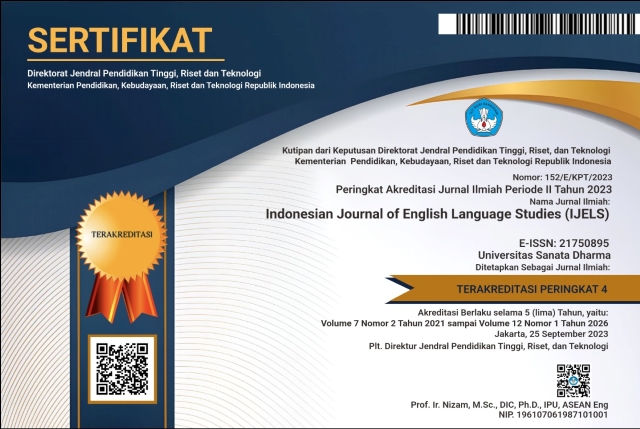Afro-American Women Discrimination on Hidden Figures : A Critical Discourse Analysis
(1) Graduate Student of English Language Studies, Sanata Dharma University Yogyakarta
(*) Corresponding Author
Abstract
This study investigates the discrimination against three Afro-American women in Hidden Figures. Critical Discourse Analysis proposed by Fairclough (2012) was used in this study to deconstruct the discrimination and provide solutions to tackle the problem. The CDA was supported by the analysis on language through Systemic Functional Grammar by Halliday (2004) and the analysis on body language by Jäger and Maier (2009). The result shows that the discrimination in the movie can be differentiated into discrimination based on the level and the cause. The discrimination based on the level includes the individual, institutional and structural discrimination. Based on the cause, discrimination based on race (racism) and dis- crimination based on gender (sexism) are illustrated in the movie. The racism is developed from racist ideology, while the sexism is caused by sexist ideology. Finally, the ideologies are represented through language and body language.
Keywords
Full Text:
PDFReferences
Ahern, Sarah. (2017, November 30). Di- rector Theodore Melfie on Why He Dropped ‘Spider-Man’ to Board ‘Hidden Figures’. Variety. Re- trieved from https://variety.com/2017/scene/new s/theodore-melfi-dropped-spider-man-for-hidden-figures- 1202626770/
Akogbeto, Patrice C. and Koukpossi, Al- bert O. (2015). Gender Issues in the Lion and the Jewel by Wole Soyin- ka: A Linguistics-Oriented Analy- sis from a Systemic Functional Grammar and Critical Discourse Analysis Perspective. Communication and Linguistics Studies, 1(2), 16-34.
Bodenhausen, Galen V. and Richeson, Jennifer, A. (2010). Prejudice, Ste- reotyping and Discrimination. Baumeister, Roy F. and Finkel, Eli J (Eds.), Advanced Social Psychol- ogy: The State of the Science. (pp. 341-383). Oxford: Oxford Univer- sity Press.
Catalyst. (2004). Advancing African- American Women in the Work- place: What Managers Need to Know. New York: Catalyst Publication.Eggins, Suzanne. (2004). An Introduction to Systemic Functional Linguistics. London: Continuum International Publishing Group.
Collins, Patricia Hill. (2001). What’s in a Name? Womanism. Black Femi- nism, and Beyond. The Black Scholar, 26 (1), 9-17.
DuMonthier, Asha, Childers, Chandra, and Milli, Jessica. (2017). The Status of Black Women in the United States. Washington: Institute for Women’s Policy Research. Retrieved from https://www.domesticworkers.org
Erbland, Kate. (2017, August 10). How ‘Hidden Figures’ Is Continuing to Inspire the Next Generation of Female Leaders. IndieWire. Retrieved from http://www.indiewire.com/2017/08/h idden-figures-state-department- program-1201865330/
Fairclough, Norman. (2012). Critical Discourse Analysis. Online article, Retrieved October 3rd, 2017, from www.academia.edu/3791325/Critic al_discourse_analysis_2012_
Fershtman, Chaim, Gneezy, Uri, and Ver- boven, Frank. (2005). Discrimina- tion and Nepotism: The Efficiency of the Anonymity Rule. Journal of Legal Studies, 34, 371-394.
Fernandes, Lily and Alsaeed, Nora Hadi Q. (2014). African Americans and Workplace Discrimination. Euro-pean Journal of English Language and Literature Studies, 2(2), 5-76.
Frauenberger, Sandra. (2012) Ending Gender Stereotyping and Sexist Portrayals in Advertising. FemCities Conference 2012, Online document, Retrieved on October 4th, 2017, from https://www.wien.gv.at
Gerot, Linda and Wignell, Peter. (1994). Making Sense of Functional Grammar. New South Wales: Antipodean Educational Enterprises.
Halliday, M.A.K. (2004). An Introduction to Functional Grammar: Third Edition. New York: Oxford University Press.
Jäger, Siegfired and Maier, Florentine. (2009). Theoritical and Methodological Aspects of Foucauldian Critical Discourse Analysis and Dispositive Analysis. Ruth Wodak and Michael Meyer, (Eds.), Methods of Critical Discourse Analysis: Second Edition. (pp. 34-61). London: SAGE.Lamsal, Mukun- da. (2012). The Structuration Approach of Anthony Giddens. Him- alayan Journal of Sociology & Anthropology, 5, 111-122.
Kilkenny, Katie. (2017, January 17). Why Theodore Melfi Chose to Make ‘Hidden Figures’ over ‘Spider- man’. The Pacific Standard. Re- trieved from https://psmag.com/news/why-theodore-melfi-chose-to-make- hidden-figures-over-spider-man
Lawrence, Keith and Keleher, Terry. (2004). Structural Racism. Online document, Retrieved on October 15th, 2017, from www.intergroupresources.com
Lessu, Deasy Natalia.2017. The Ideologies of Anti-Authoritarianism and Social Movement in Anti-Flag’s Protest Song Lyrics: A Critical Discourse Analysis. Yogyakarta: Sana- ta Dharma University.Marshall, Thurgood. (2005). Segregation is Morally Wrong. Karson, Jill. eds. The Civil Rights Movement. (pp. 74-85). Maine: Thomson Gale.
Pincus, Fred.L. (2000). Discrimination Comes in Many Forms: Individual, Institutional, and Structural. Online article, Retrieved on October 12th, 2017, from https://media.lanecc.edu/users/martinezp/
Rospenda, K.M., Richman, J.A., and Shannon, C.A. (2009). Prevalence and Mental Health Correlates of Harassment and Discrimination in the Workplace: Results from a National Study. Journal of Impersonal Violence, 24(5), 9-43.
Sarrasin, Oriane, Gabriel, Ute, and Gygax, Pascal. (2012). Sexism Attitudes towards Gender-Neutral Language: The Case of English, French and German. The Swiss Journal of Psychology, pp.1-37.
Tenorio, Encarnation Hidalgo. (2011). Critical Discourse Analysis: An Overview. Nordic Journal of Eng- lish Studies. 10(1), 183-210.
United Nations. (2001). Gender Dimensions of Racial Discrimination. Se- attle: PhotoDisc, Inc.
Wodak, Ruth and Meyer, Michael. (2001). Methods of Critical Discourse Analysis. London: SAGE Publication Ltd.
West Virginia Department of Education. (2017). Hidden Figures: Instructional Guide. Online document,. Retrieved on April 3rd, 2018, from https://wvde.state.wv.us/instruction
/documents/HiddenFiguresCurricul um-WestVirginia1.pdf
DOI: https://doi.org/10.24071/ijels.v4i1.1631
Refbacks
- There are currently no refbacks.

This work is licensed under a Creative Commons Attribution-ShareAlike 4.0 International License.
IJELS Journal Sinta 4 Certificate (S4 = Level 4)
We would like to inform you that Indonesian Journal of English Language Studies (IJELS) has been nationally accredited Sinta 4 by the Ministry of Education, Culture, Research and Technology of the Republic of Indonesia based on the decree No. Surat Keputusan 152/E/KPT/2023. Validity for 5 years: Vol 7 No 2, 2021 till Vol 12 No 1, 2026

This work is licensed under CC BY-SA.
Creative Commons Attribution-ShareAlike 4.0 International License
IJELS e-ISSN 2715-0895; IJELS p-ISSN 2442-790X
Indonesian Journal of English Language Studies (IJELS) is published twice a year, namely in March and September, by the English Language Studies (ELS) of the Graduate Program of Sanata Dharma University, Yogyakarta, Indonesia.


 IJELS p-ISSN:
IJELS p-ISSN: 









